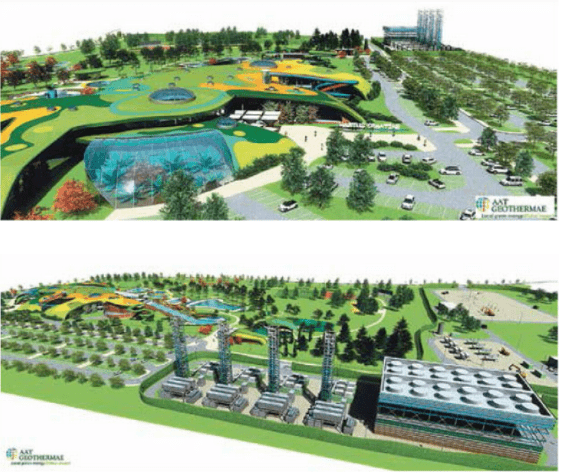Big news for Međimurje!
In Draškovec near Prelog in Međimurje, the first phase of a geothermal power plant will be put into operation in the middle of next year. The first of its kind in this part of Europe, the power plant will deliver clean, efficient and stable electricity to the power grid and provide cheap energy from the local source in Međimurje, reports Jutarnji List on August 31, 2017.
This innovative project of the Swiss investment fund CloZEd Loop Energy and their Croatian company AAT Geothermae is worth about 75 million EUR. Around 14.7 million EUR was granted through the Ministry of Environmental Protection and Energy of the Republic of Croatia, co-financed by the European Commission from the NER 300 Program for the most innovative technological solutions in the fight against climate change.
Croatia will be in the company of just 20 other countries in the world that have functional geothermal power plants. Croatia will also become the first country in the world where the first advanced geothermal power plant of the new generation has been developed and put into operation.

This project will surely put Croatia on the global map of innovation in renewable energy sources and the fight against climate change. The first classic geothermal power plant was built in Larderello, Italy, and for almost 50 years it was the only geothermal power plant in the world. Today, the largest producers of electricity from geothermal sources comes from the Philippines, USA, Mexico, Italy, Japan, New Zealand and Costa Rica.
This new generation geothermal power plant will be built near the former INA thermal well in Draškovac. The project is unique because it uses the innovative concept of a closed circuit with the so-called “internalization” of carbon compounds.
The geothermal energy in Draškovec will, for example, extract thermal water from depths of about 1800 to 2300 meters, but also all of the gases completely dissolved in it, mainly methane, and will use it as energy and water heat. This will not pollute the environment, and the geothermal power plant will help in the long-term regeneration and renewal of the thermal resources used for energy production.
The innovation and value of the project are also reflected by the fact that it has been awarded funding from the European Commission’s managed NER 300 programme, which is intended solely for the financing of innovative, climate-friendly technologies. The NER 300 programme has awarded funding to 39 projects across the EU. The geothermal project in Draškovec is one of the six approved projects from Eastern and Central Europe and one of the three geothermal projects awarded by the programme.
In 2014, the project went through a comprehensive six-month “due diligence” process that was carried out by experts from the European Investment Bank. The project was given a very high rating.
It is also worth mentioning that the then commissioner of the European Commission for Combating Climate Change, Connie Hedegaard from Denmark, particularly commended the representatives of the Croatian Ministry of Environmental Protection and Energy, and especially Croatia’s contact point for the NER 300 program, who did a great job in the project application and its follow-up.
The first phase of the geothermal power plant construction project in Draškovec started in the second half of 2015. Much of the construction and mining works have been done in the last year and a half, and all other construction works should resume in November. All of the key elements of technical equipment that will be installed at the plant have already been made in the factories, and as soon as the mining and construction works are completed, they will be installed in the power plant.
In the first phase, by the middle of next year, the geothermal power plant in Draškovec should produce about 3.6 megawatts of electricity and about 10 megawatts of thermal energy.
After the completion of the first phase, the project should resume immediately, and by the end of next year, the geothermal power plant should produce about 7.2 megawatts of electricity and 24 megawatts of thermal energy. The project should be fully completed by the middle of 2019 and produce around 18.6 megawatts of gross electricity, of which about 10 megawatts will go to HEP’s distribution network and about 60 megawatts of thermal energy.
Peter Vesenjak from AAT Geothermae says that with the City of Prelog, which is incredibly supportive of this project, they have already signed a contract for the development of the district heating network. The design and feasibility studies for this project, which will serve as the final closure of the financial structure of the project, will be completed so that the thermal energy produced in the geothermal power plant in Draškovac will be delivered to the district heating network. This will enable the local population and entrepreneurs to lower heating and cooling costs.
“This should significantly improve the quality of life and increase the standard of Prelog and the surrounding towns as it will drastically reduce their heating costs and at the same time, significantly improve environmental standards in the long run. Individual consumers also showed a keen interest in the areas 10 kilometers around Prelog, such as agricultural producers with greenhouses and some larger industrial plants. This will also trigger the related investment cycle of the entrepreneurial sector in the environment and a significant number of new, high-quality jobs, and will also increase the attractiveness of this area and prevent young people from leaving, as well as encourage the arrival of new residents,” concluded Vesenjak.
Translated from Jutarnji List








